Pictures on Flickr can be found here:
Paraguay https://www.flickr.com/photos/colinchurcher/albums/72157607011216273/
https://www.flickr.com/photos/colinchurcher/albums/72177720330003522/
Chile https://www.flickr.com/photos/colinchurcher/albums/72157607011231603/
https://www.flickr.com/photos/colinchurcher/albums/72157607007299952/
Argentina https://www.flickr.com/photos/colinchurcher/albums/72157607013806781
https://www.flickr.com/photos/colinchurcher/albums/72157607010477660/
https://www.flickr.com/photos/colinchurcher/albums/72157607010477694/
Saturday 14 October 1995
Our three week vacation in Paraguay,
Chile and Argentina got off to a propitious start at home in Ottawa
(or unpopicious, depending on your definition) when a pigeon pooped
on Mary's head less than an hour before we had planned to leave for
the airport. With a flight leaving after lunch, we finished our last
minute packing in the morning and then wandered through the market
for a final cappuccino at Grabba Jabba. The pigeon did it's dirty
deed just as we were going into the cafe - maybe this was an omen. We
then came home where Mary did a fast clean up job and then we toted
our bags through the Rideau Center to catch the #96 bus to the
airport. The new part of the transit was good and we arrived at the
Air Canada check-in within half an hour of leaving downtown.
We had an uneventful flight through
Toronto to Miami where we met the rest of the group and checked into
Ladeco.
Sunday 15 October 1995
The overnight flight to Santiago was,
again, uneventful although Ladeco really crams people in. Customs was
very quick and efficient in Santiago and we were soon in a bus on our
way downtown. Santiago seems to take a little time to get going on a
Sunday morning. We had a look around the railway station where
pigeons are a real problem - Mary was very nervous about being
anywhere underneath pigeons due to her recent unhappy experience.
From there we visited the San Eugenio workshops and the Quinta Normal
park. Santiago is very pleasant at this time of year with avenues of
trees with white blossoms. The snow capped mountains that surround
the city provide an excellent backdrop.
Back at the airport we boarded a flight
to Asuncio. A flight just ahead of us was going to Montevideo and a
large part of the complement was a boisterous mixed choir going to a
competition. They kept bursting into wonderful song and were
vigorously applauded after each one by the other waiting passengers.
One woman in particular had a beautiful voice. The airline staff
could not make themselves heard above the singing and general hubbub
and had to wait for the slightly quieter moments in between songs to
make their boarding announcements. Our flight to Asuncion was quite
good and the meal was excellent. The city had obviously had quite a
heavy recent rainfall. The red mud roads that are plainly visible
from the air were very wet and there were a few flashes of lightning
as we took our bus downtown to the hotel.
We decided to go out for a meal.
Several of the streets were not well lit and so we decided to stay
close to the hotel. We found a good restaurant and managed to make
ourselves understood quite well.
Monday 16 October
We
slept very well and were down in good time for the charter street car
ride through town. The street cars were very late in arriving because
there had been some problem with the wires being brought down in a
recent storm. The general manager of the company came to meet us to
tell us that the cars were coming but it was a long time before
#9007, in white, turned up. In the meantime we stood about watching
the city of ocean wake up and it's citizens go to work. The stalls in
the plaza began to be set up. The fellow at the leather store put up
a nice selection of leather bags, and a number of the group went over
to check them out.
As
it turned out the streetcar system now only has two operable street
cars and the company suspended service so that we could have our
charter. They probably made more money that way. The line is in very
poor shape and cannot last much longer. The whole operation is quite
moribund and the carbarns present a scene of utter desolation. It is
difficult to understand how it can keep operating.
Every
so often we had to stop to clear the flange way and at one point we
climbed a three inch pile of mud across the rail. At one point we
found ourselves going the wrong way down a one-way street with
traffic passing us on both sides in the opposite direction. We were
stopped by a taxi parked across the tracks with a flat tire. The
group soon solved this problem by bouncing the vehicle out of our
way. Everyone had a wonderful time doing this, it was an excellent
team building exercise that served to break the ice in the group at
the beginning of the trip. As the street car went up the hill, we
looked back at the taxi sitting just disconsolately and lopsidedly in
the middle of the street with traffic zooming by it on both sides.
With delicious anticipation, and regret that we couldn't see it, we
imagined the look on the taxi driver's face when he returned to find
his taxi in the middle of the road.
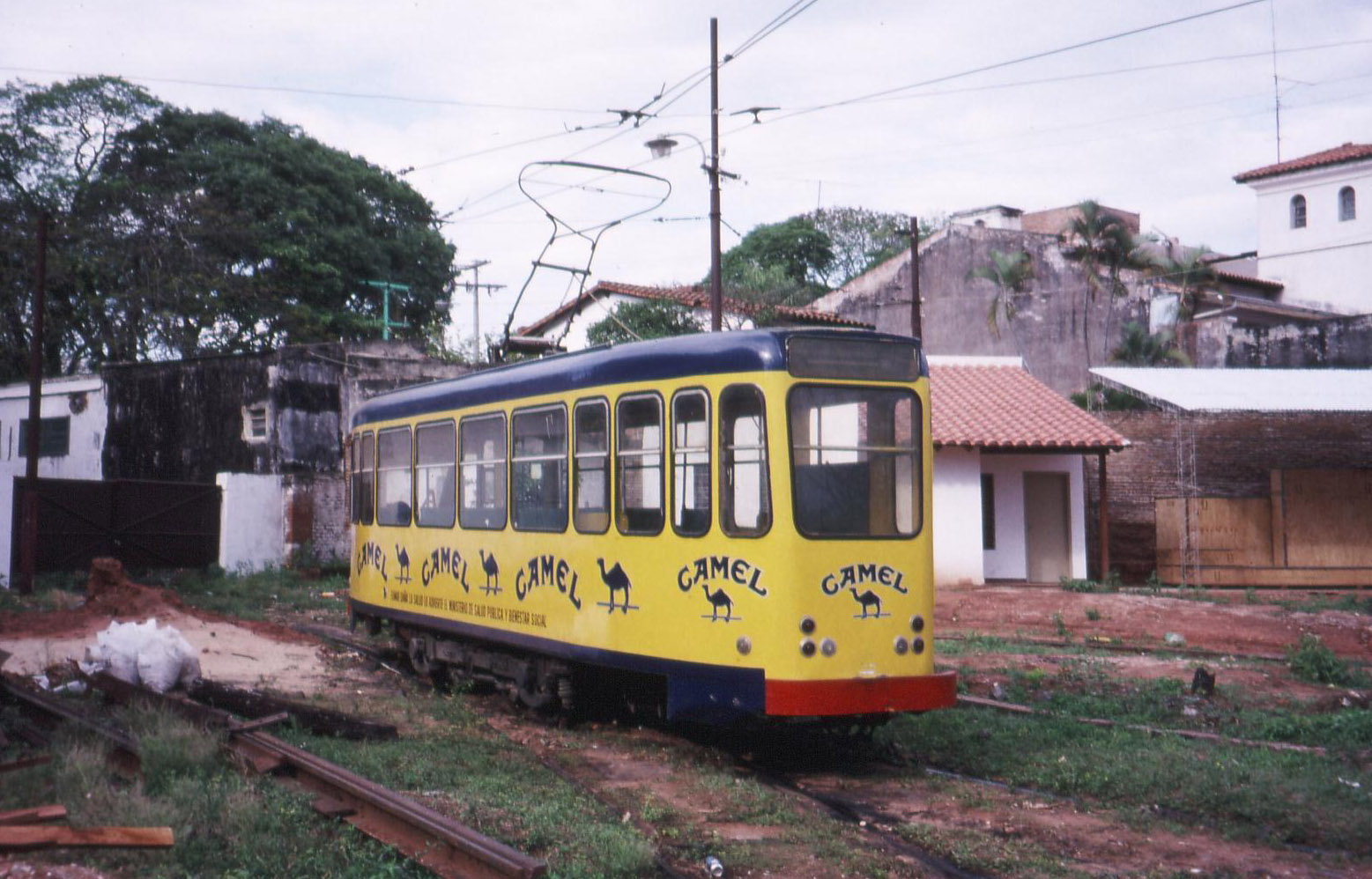 
Left Asuncion car shops - Right Taxi blocking our way
The
streetcar brought us back to the station where we were greeted by the
two musicians who accompanied us last year, one with a Paraguayan
harp and the other with a guitar. Our train was hauled by #152 which
turned out to be a good, strong engine. We departed in heavy rain. We
saw the doorways of several houses decorated with dozens of balloons,
even saw a woman carrying a great billowing cloud of them down the
street with the wind carrying them onto the windshields of passing
cars. A local guide told us that these balloons are used to decorate
the doorways of houses to celebrate birthdays, perhaps similar to the
pink flamingos placed on North American lawns for birthdays and
anniversaries?
The
weather improved as we made our way into the chaco but there were
overcast skies all day.. Beer (Heineken) in the diner was followed by
lunch which was built around surubi (Paraguayan catfish). This year
we came across a hot sauce from Brazil (Molho Pimienta Vermaelha by
Aristo) which Mary was able to find in Encarnacion later on.
This
being a Monday, Sapucay works was in full operation. The steam engine
operating the belts was working and the belts slapped around above
our heads. In the works were steam engines #60 and #101 under heavy
repair while 2-6-2 tank engine #5 was in steam in the yard. It is
business as usual even though the railway cannot last much longer. In
a similar vein, there were many piles of ties along the right of way
ready to be installed.
At
Sapucay horses were running freely along the platform and there was a
delay while a broken pedestal casting was replaced. It was
interesting to see it done as this was accomplished with the use of
hand operating jacks and they didn't even get the passengers out of
the car. The tricky bit was to get the new casting lined up after it
had been fitted over the axlebox. The old pedestal had been broken
for some time because the break was rusty. In all it took about 45
minutes. Not bad for a crew working in flip-flops.
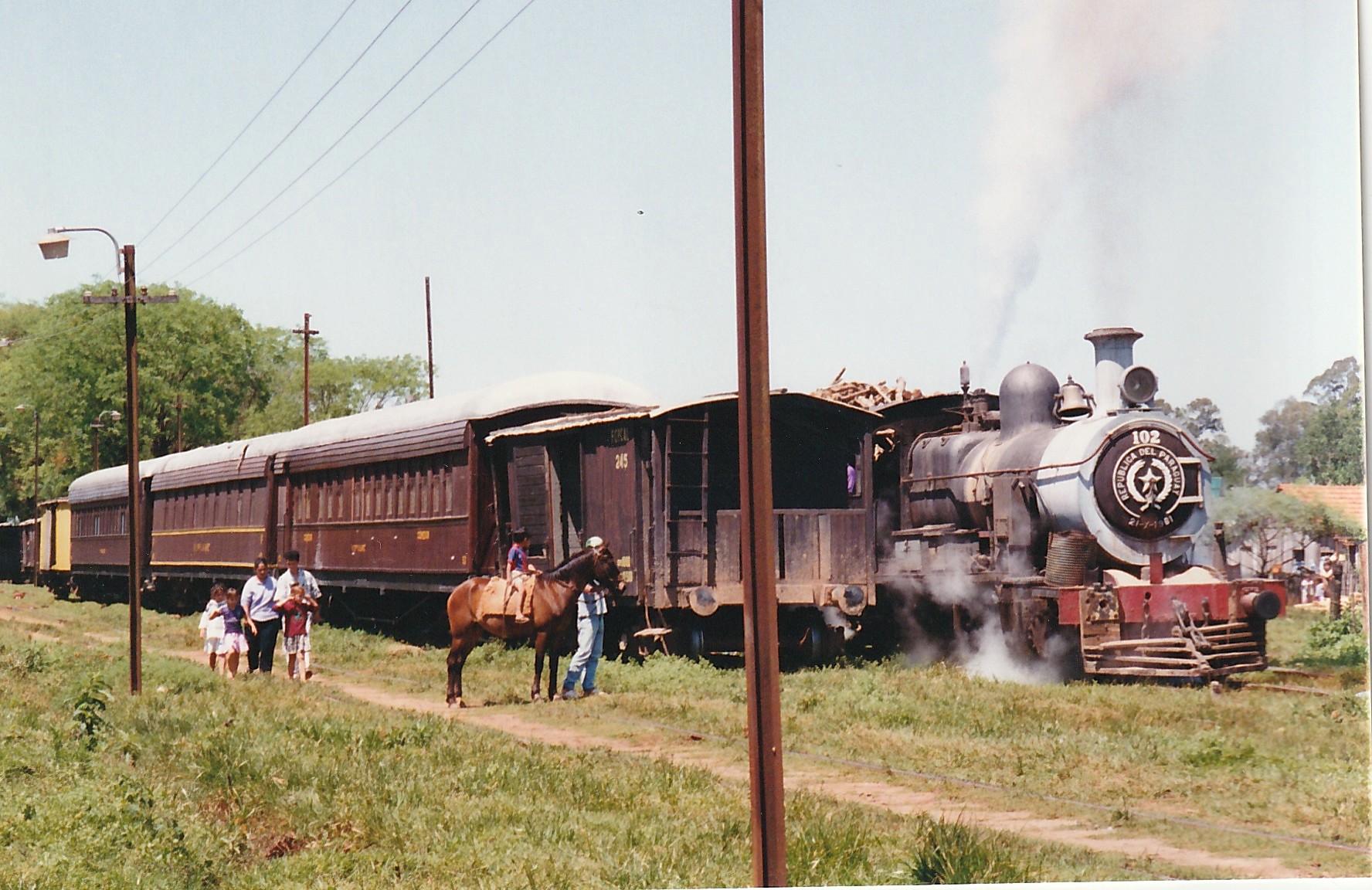
We
had more rain and the visit to Tebicuary Sugar Mill was curtailed.
The last part of the journey was in the dark and we could hear the
frogs which made a mewing sound like a cat. Two buses took us to the
hotel at Villarica and we turned in early for the night.
Tuesday
17 October 1995
We
were up early and after a quick breakfast, went back to the train for
the long ride across the rest of the railway to Encarnacion. It was
misty and this provided some interesting effects for photography.
They were a great number of spiders' webs which were shown up by the
dew it is surprising how extensive some of these were - one system
was spun across a 20 foot stream.
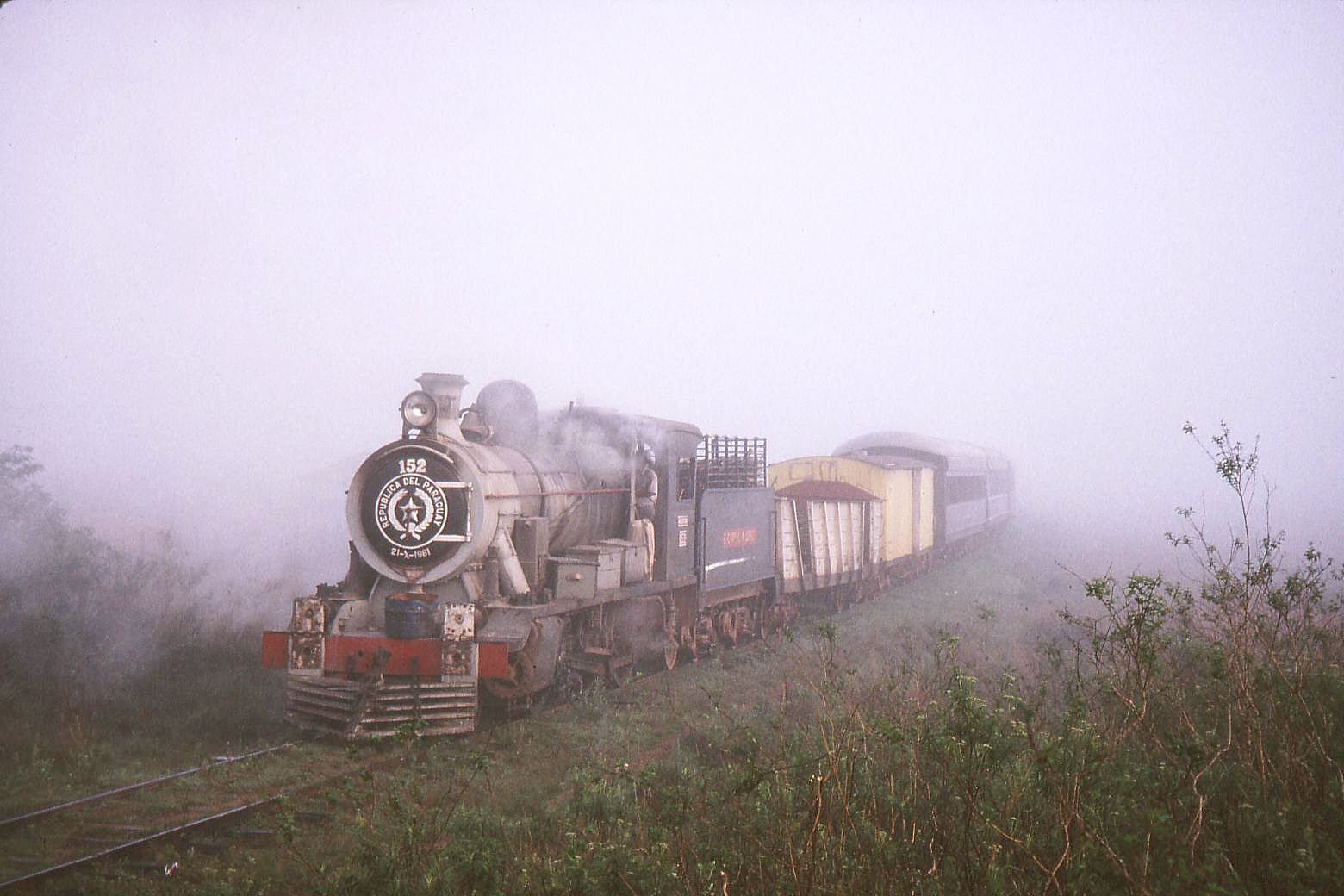 
Right - San Salvador Junction
Wildlife
was interesting on the stretch to San Salvador junction. There were
several large hawks and we saw two rheas. We saw owls close to their
burrows together with roadrunners and their chicks. There were many
wild pineapples as well as cactus. The land is used mainly for cattle
but the fields are dotted with termite mounds and the occasional
white cattle egret.
At
San Salvador Junction #152 came off and number #59 was attached to
our train. This was a mistake as the only good thing about number 59
was the red paint job. We had seen #59 in Sapucay shops under repair
last year. It was obviously in trouble before we left with a leak in
the pipe leading to the backhead which serves the auxilliaries. #235
was on washout while #524 was dead in the shed. We had a walk around
San Salvador junction which is very much a one horse town, literally.
The streets are all red mud. The houses are spread out and we could
hear radios but otherwise very little sign of life. There is a very
wide broad patch of grass on the center by the railway in which pigs
and piglets were rooting around while youngsters were
indiscriminately digging up pieces of sod and carting them away. A
guide explained that Paraguayans are great believers in naturopathy,
and this sod contains small plants that are collected and sold in the
markets for their heating properties and as a source of revenue.
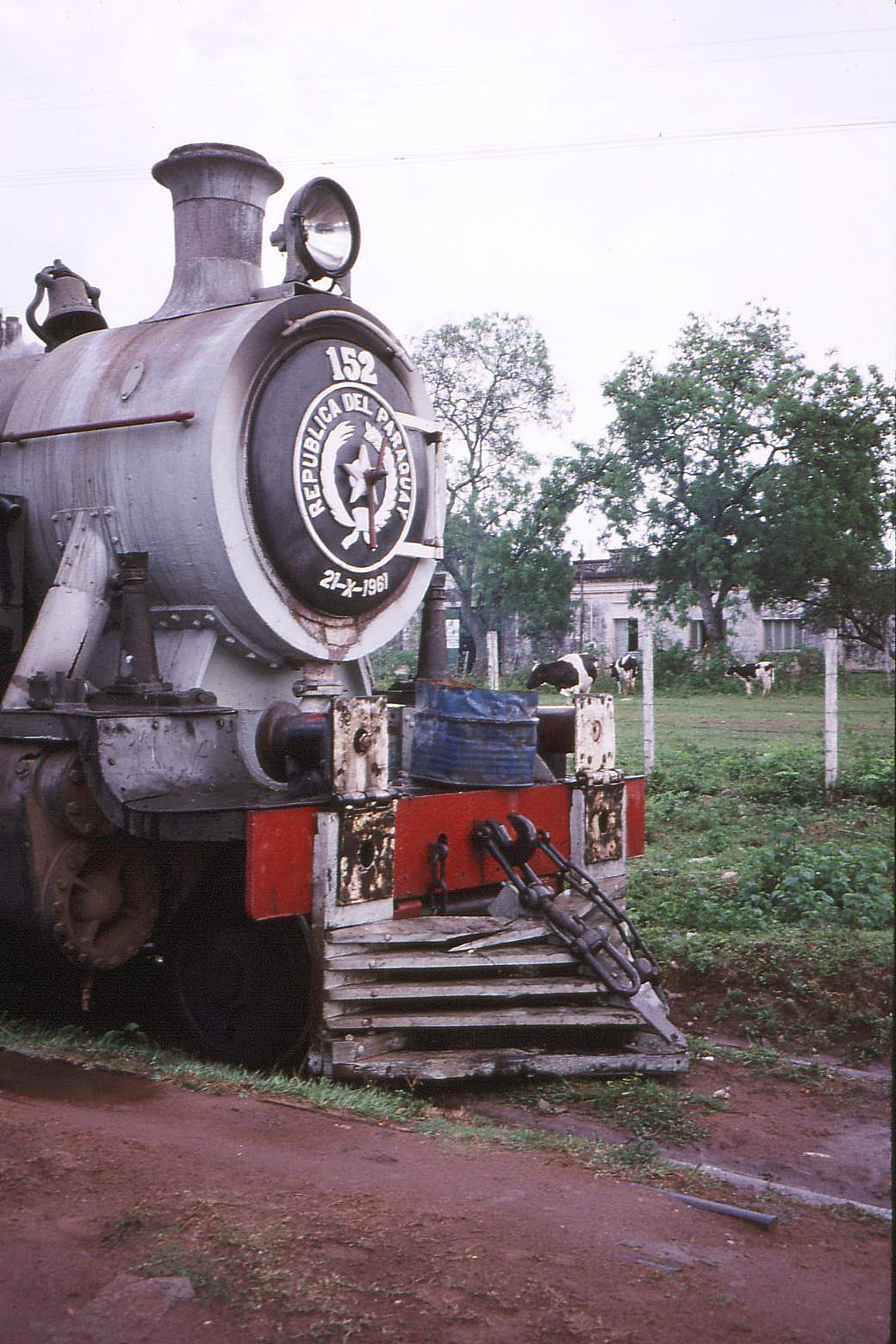 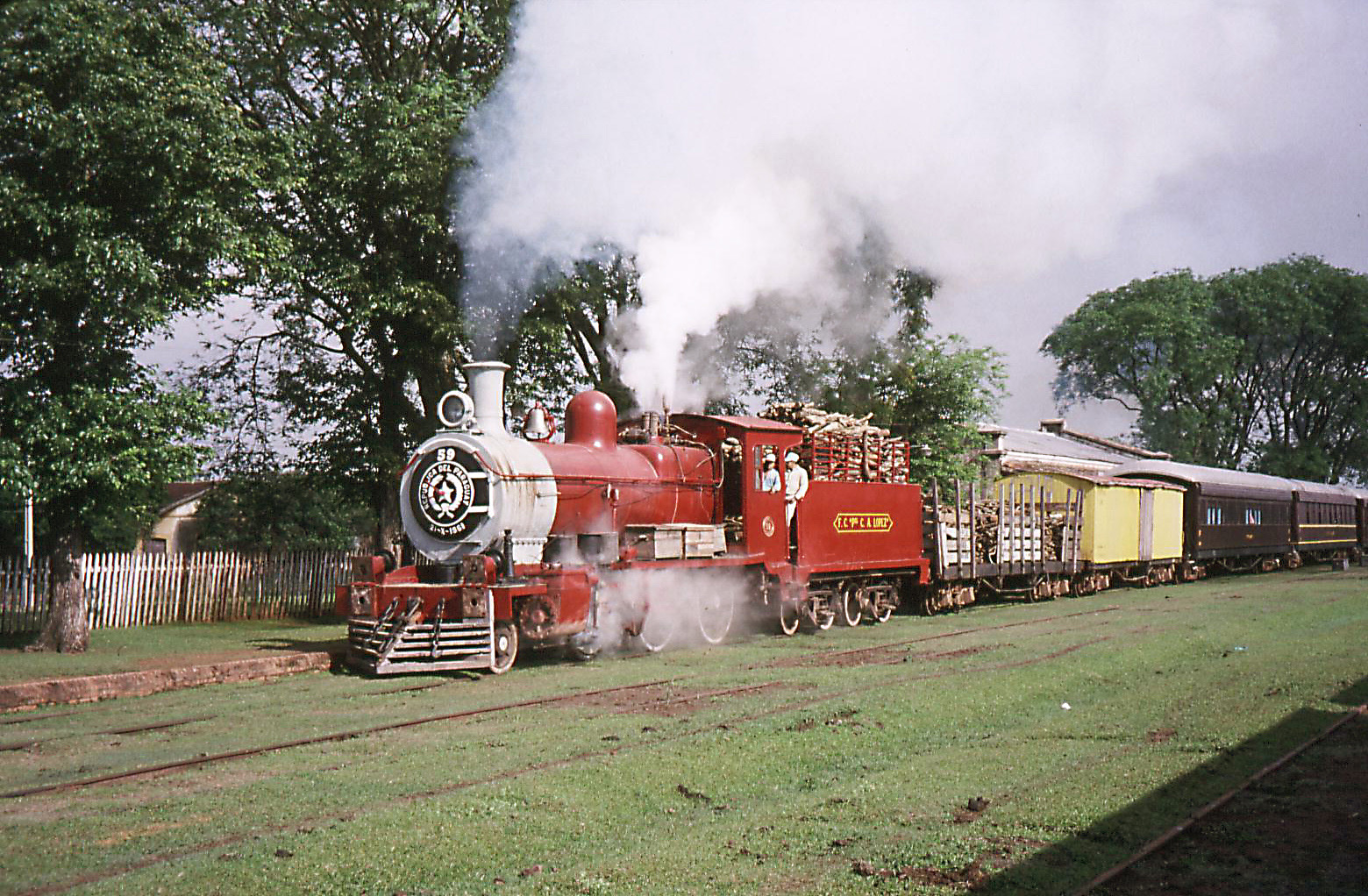
We
set off in high spirits into a riot of wildlife. Red-breasted
kingfishes, swallows with long forked tails and emerald ducks were in
profusion. There was much water and this was covered with water
hyacinths as well as a form of bellbine weed with a hibiscus type
flower. Wild orange trees grew along the right of way and there were
several cattle skulls and odd bones lying around. In places thistle
was blooming in a pink profusion and there were black and red
butterflies. Iturbe has wide red but streets. Colin gave an Operation
Lifesaver pin to a small kid. He skipped away and then showed it to
everyone at the station. Our maximum speed was about 15 miles an hour
and it soon became evident that #59 had a front bearing problem. It
would run for about 40 minutes and then there would be a 20 minute
plus break while the crew attended to the bearing. We waited by a
bridge over a branch of the Tebicuary river for about 45 minutes
while they worked on the bearing. It was a wonderful setting and the
pictures were very good but we were bothered by the mosquitoes.
 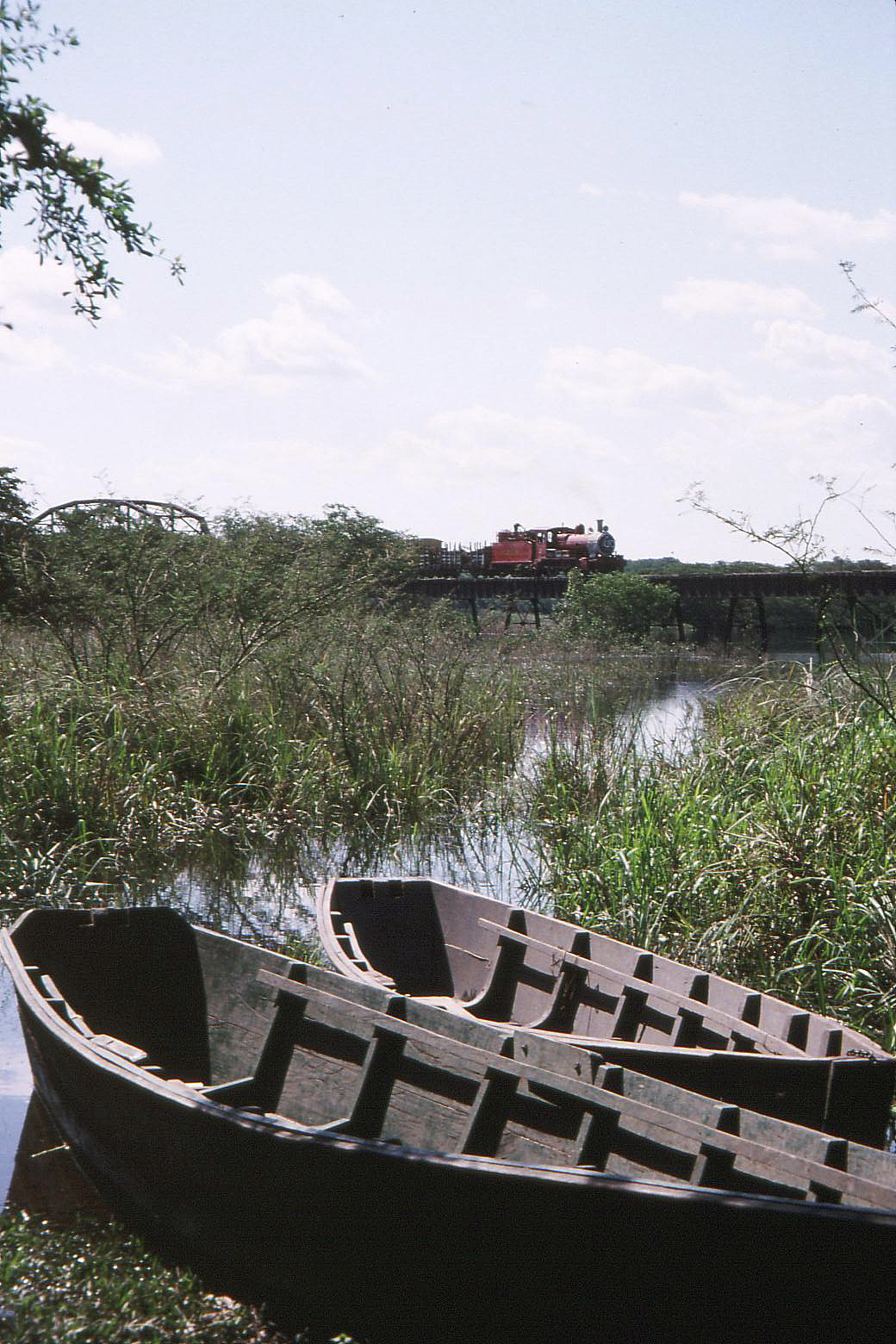
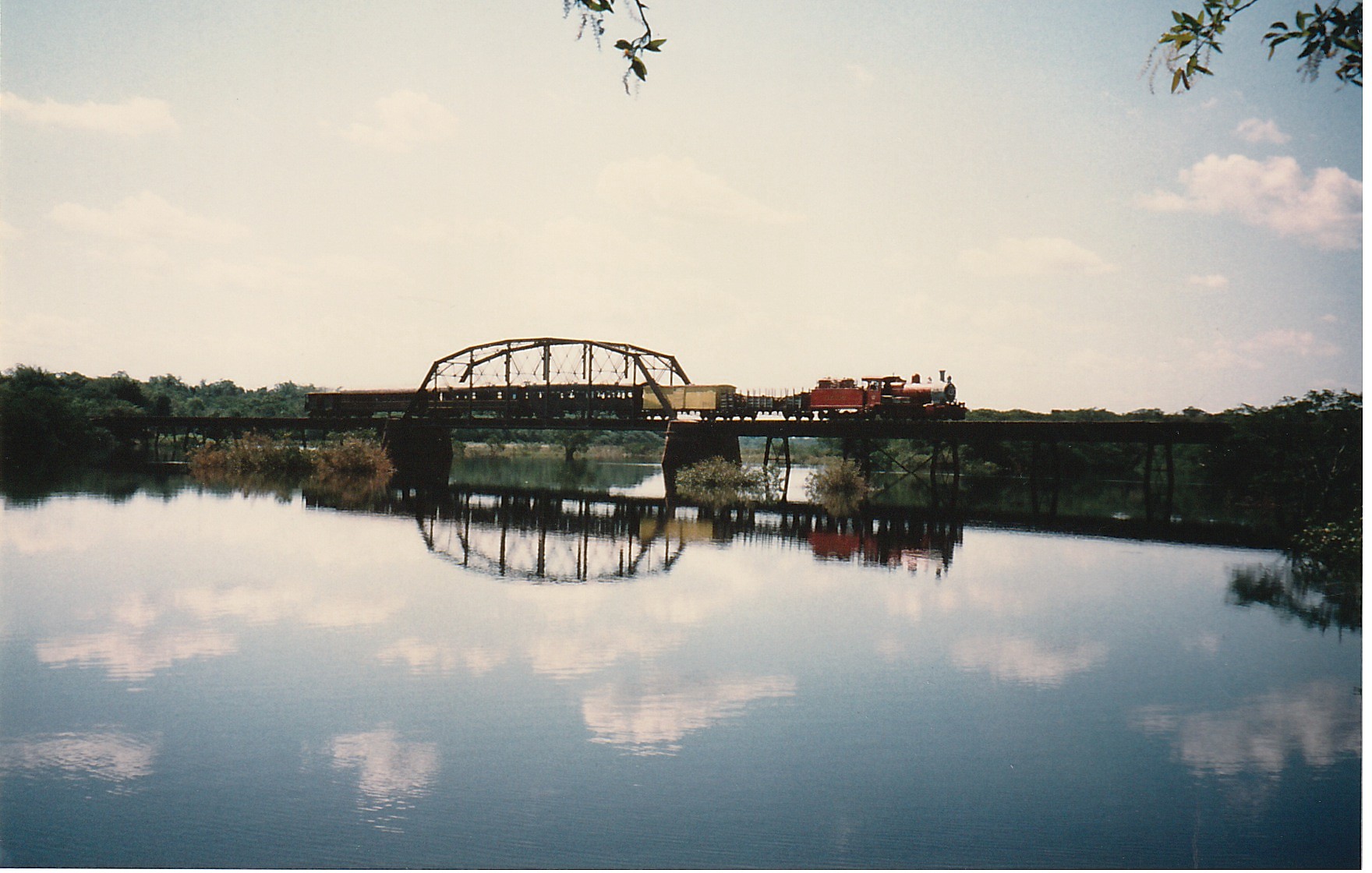
The
train train lost about three and a half hours due to the bearing but
we enjoyed the scenery. The land was pretty flat with lots of water.
The small towns were interesting and many people, especially
children, came out to see us. Several of the farms had bamboo growing
around the corral. At one point, towards evening, we passed a boy
sitting bareback on a brown horse which was up to his chest in a
pond. What a great way to cool off after a hot day.
We
ate two meals in the restaurant car (comedor), chicken for lunch and
steak for dinner. Both were very good. While waiting for dinner we
bought manioc rolls from a lady at the station, a typical Paraguayan
bread. She was selling them from a carrier on her bicycle. They
tasted a little of fennel. While we were eating the musicians
performed although, at times, they were almost drowned out by the
merriment of the eaters. It was such a tight squeeze in the aisle
that whenever the waiter needed to get someone a beer, the guitarist
had to stop playing and reach behind himself for a bottle and pass it
over to the waiter. When not serving meals the car was open for beer
and the beverages.
As
it became dark we realized that there were no lights in the train
except in the comedor so movements were carried out using
flashlights. Many stayed in the comedor and drank beer. Whenever the
train stopped we were treated to the cat like mewing from the frogs
outside. We arrived at Abogado around 22:15 to find that #54 had been
sent down from Encarnacion to rescue us. Even better, a bus arrived
to take some of us directly to the hotel. There was some concern that
the bus would not have enough room for everyone who wished to get to
the hotel as soon as possible. As it happened, there were more hard
cores than anticipated and there was room for everyone. We arrived at
the hotel at 23:15 while the hard core people, who stayed on the
train, made it in just before 02:00.
Wednesday
18 October 1995
The
Novotel is excellent and we were glad that we would be staying three
nights there. We got up late and had a look around the grounds. The
hotel is on the edge of town and we could see the Parana River across
the fields which will eventually become a lake when the dam is fully
operational. We took some pictures of the tame rheas (South American
ostrich) in the grounds and then went with the group to the railway
station for an inspection of the yard.
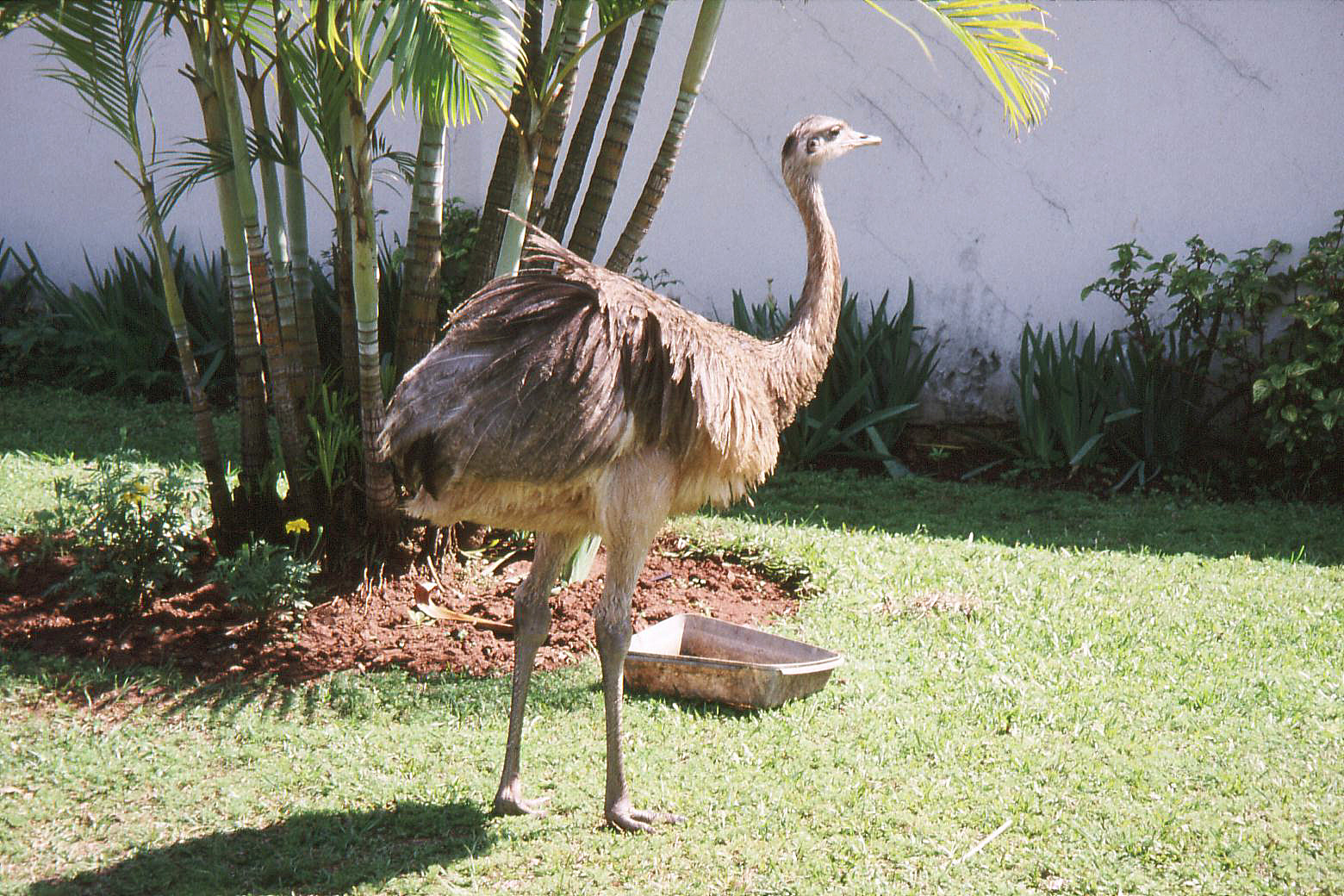 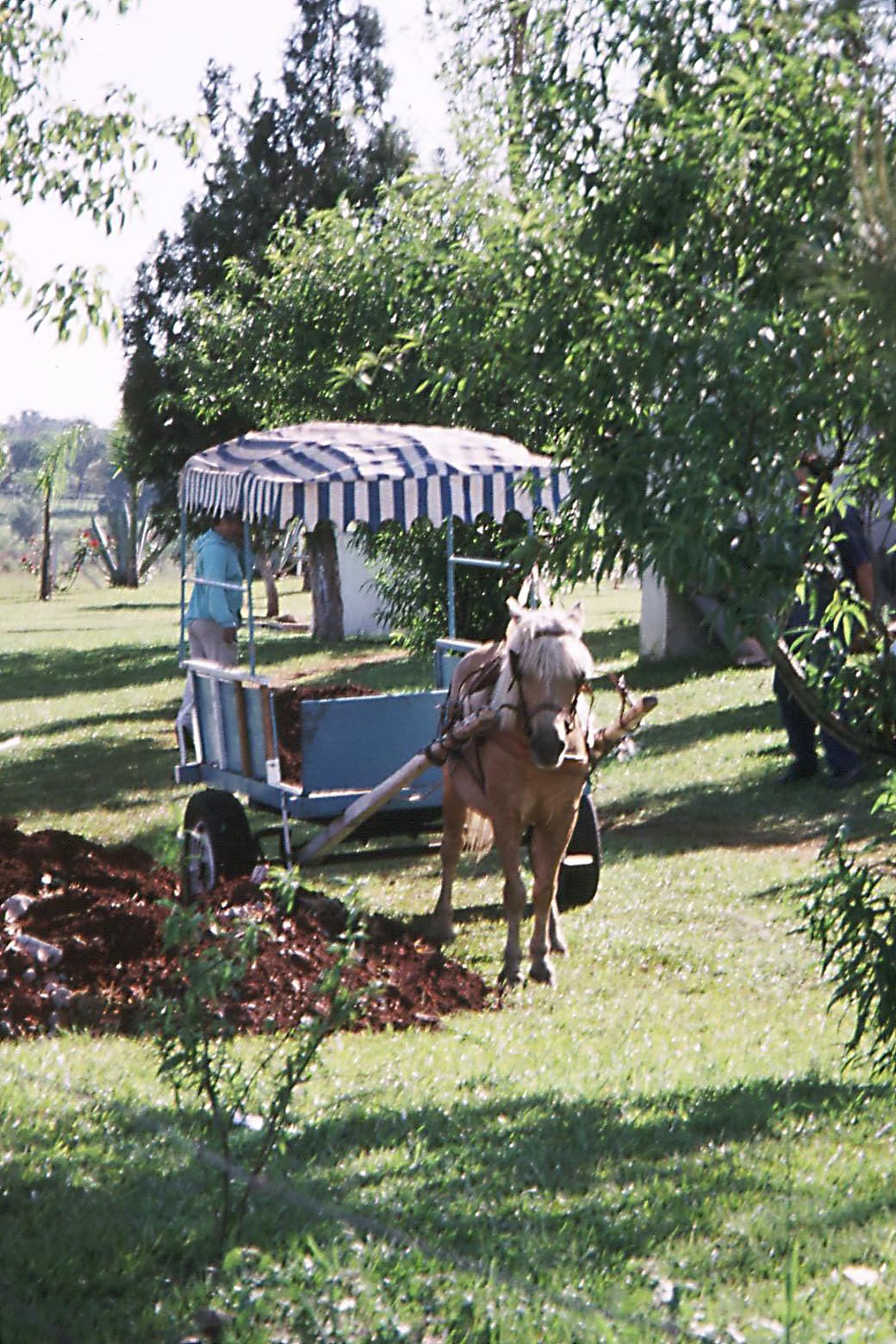
There was a surprising amount
of activity. #58, #102 and #104 all in steam, #53, #291 were dead in
the shed while #334, a formerArgentinian 2-8-0 was in the yard. The
weekly freight train to Asuncion, hauled by #102, left while we were
there. #54 was working the trips from the Encarnacion yard to the
interchange with Ferrocarrilos Argentinos on the Paraguay side of the
international bridge.
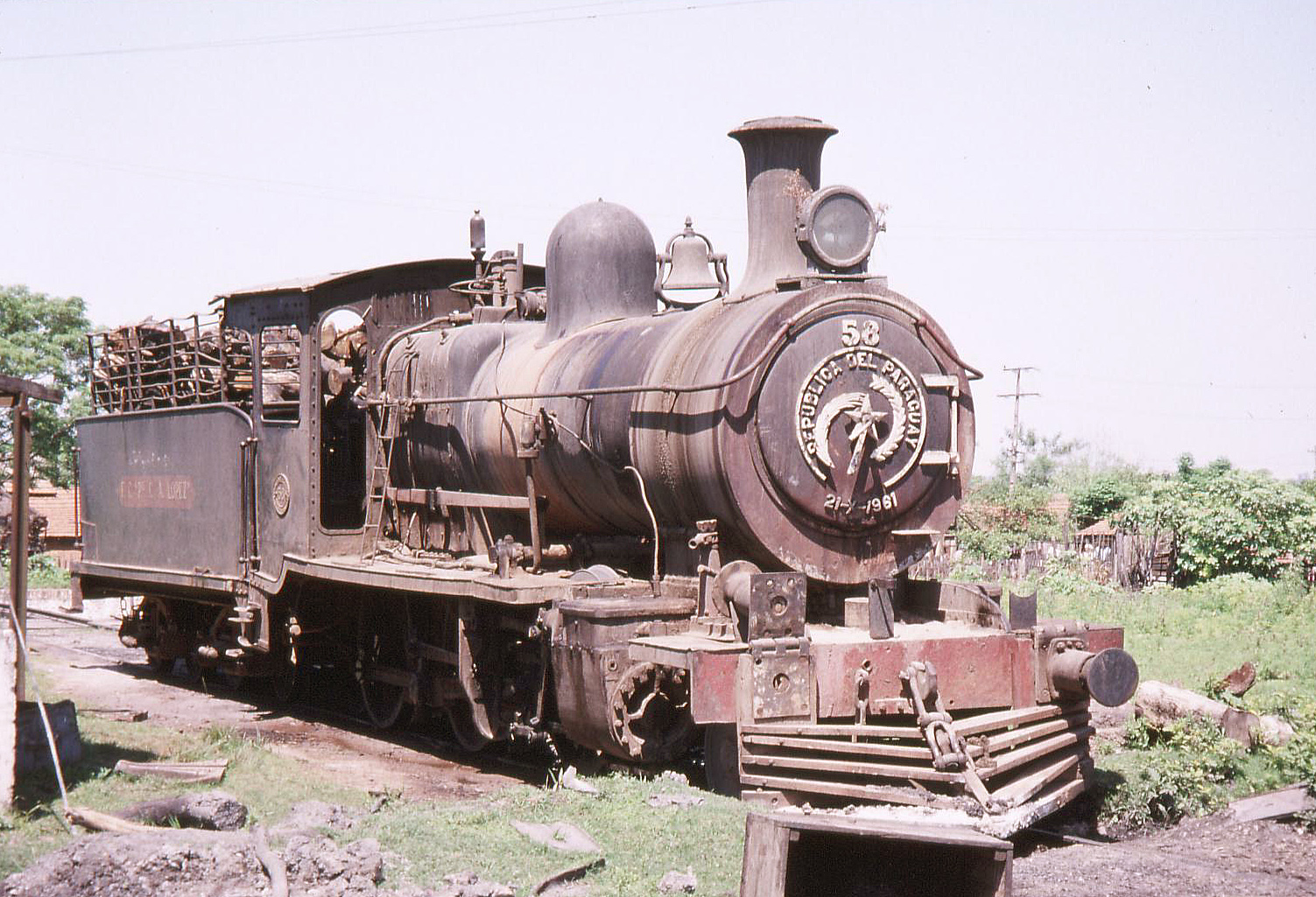 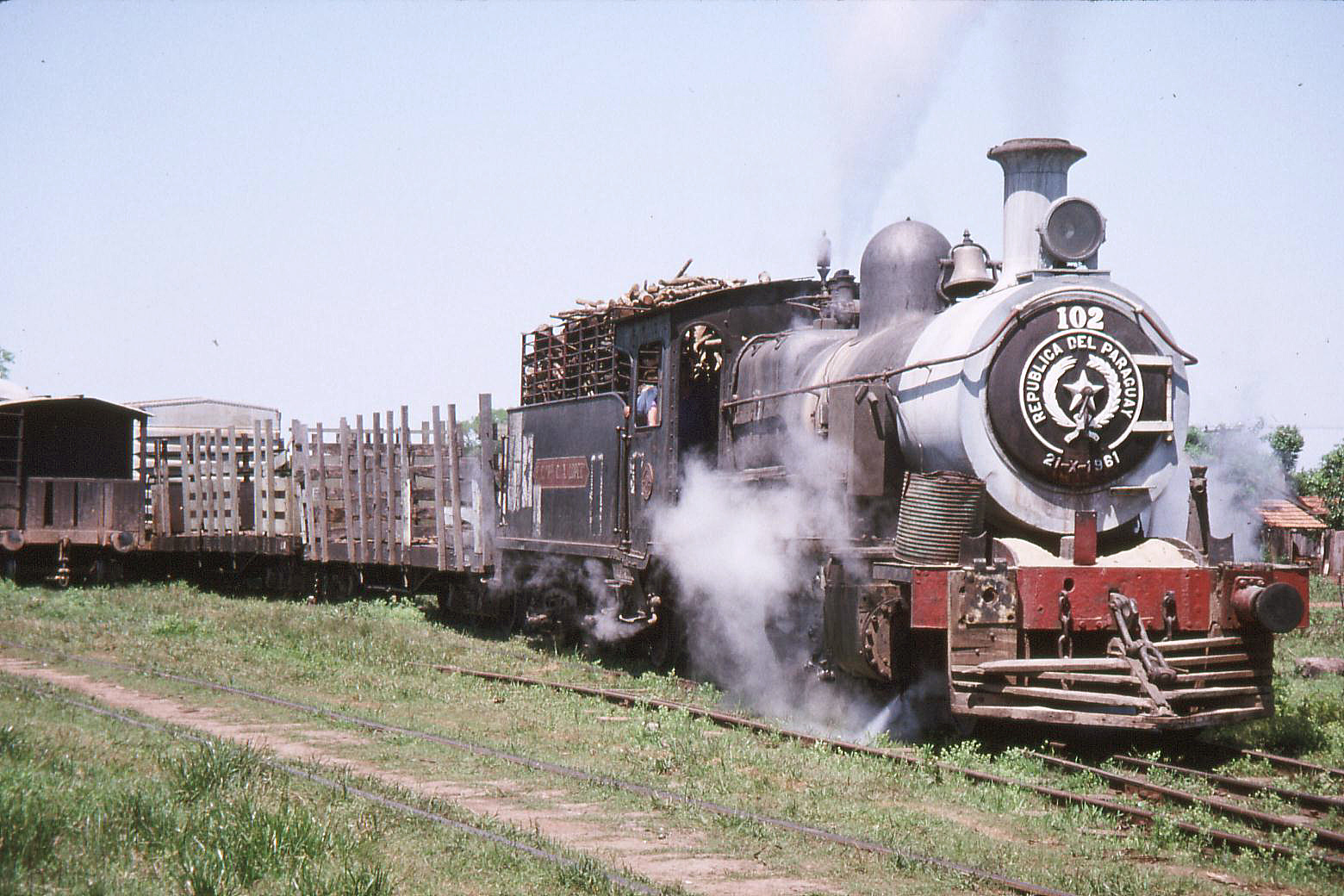
Having
said goodbye to the group that was going to Brazil we went in the bus
to Posadas where we had a late lunch. This is a pleasant town with
many jacaranda trees just coming into bloom. It is evident that
Posadas is much more prosperous than Encarnacion. The streets and
shops are better and there are no horse-drawn taxis in Posadas. We
had a look at the overgrown railway yard in Posadas where the hulks
of steam engines #230, #252 and #602 had been dumped. This will all
be flooded when the water rises.
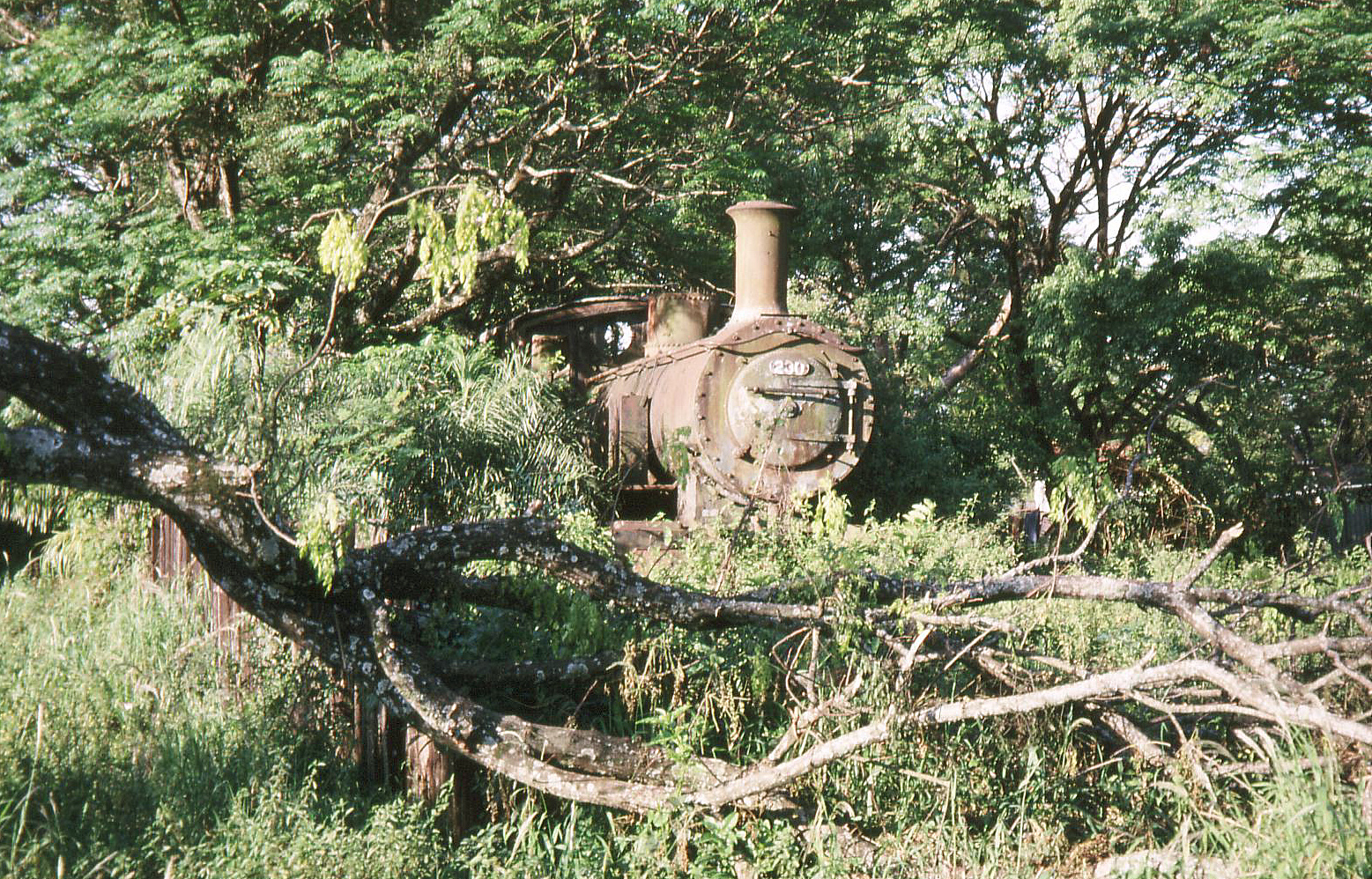 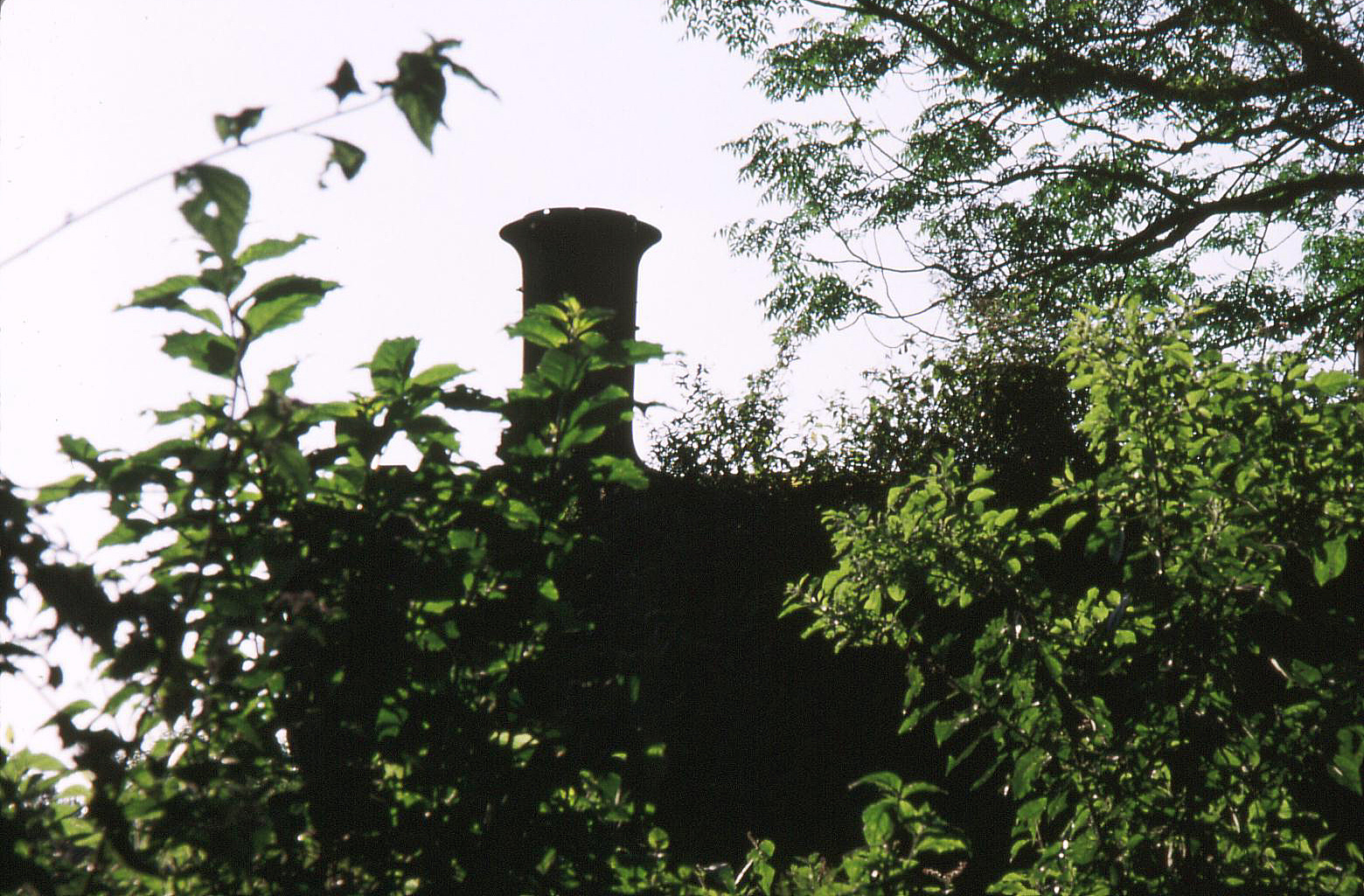
We
ate at the hotel this evening. Colin had Surubi with Roquefort
sauce which was very good, Mary had a beef steak cooked “a punto”,
or medium rare, which was also very good. Our waiter taught us the
right term for desired doneness, and we used it several times later
in the trip to great advantage when ordering beef. It was understood
in Chile and Argentina as well as in Paraguay. We also had a nice
bottle of Argentinian wine.
Thursday
19 October 1995
Today
we went to the station and rode a special freight train to Abogado and
back. #54, which rescued us a couple of days ago, was on our train
and we were reasonably sure that we would make it. #102 was working
the container sidings. The first part of our journey was through that
part of Encarnacion which will be flooded by the dam. There are many
shacks with lots of pigs and piglets. It seems there are several
small brick operations, one was using a horse on a turn wheel to
knead the clay. We had a small boy stow away called Victor, his name
was tattooed right up his arm. He was thrown off at the first run
past but evaded the conductor and got back on again. He was
eventually thrown off about 12 km out of town and had to find his own
way back.
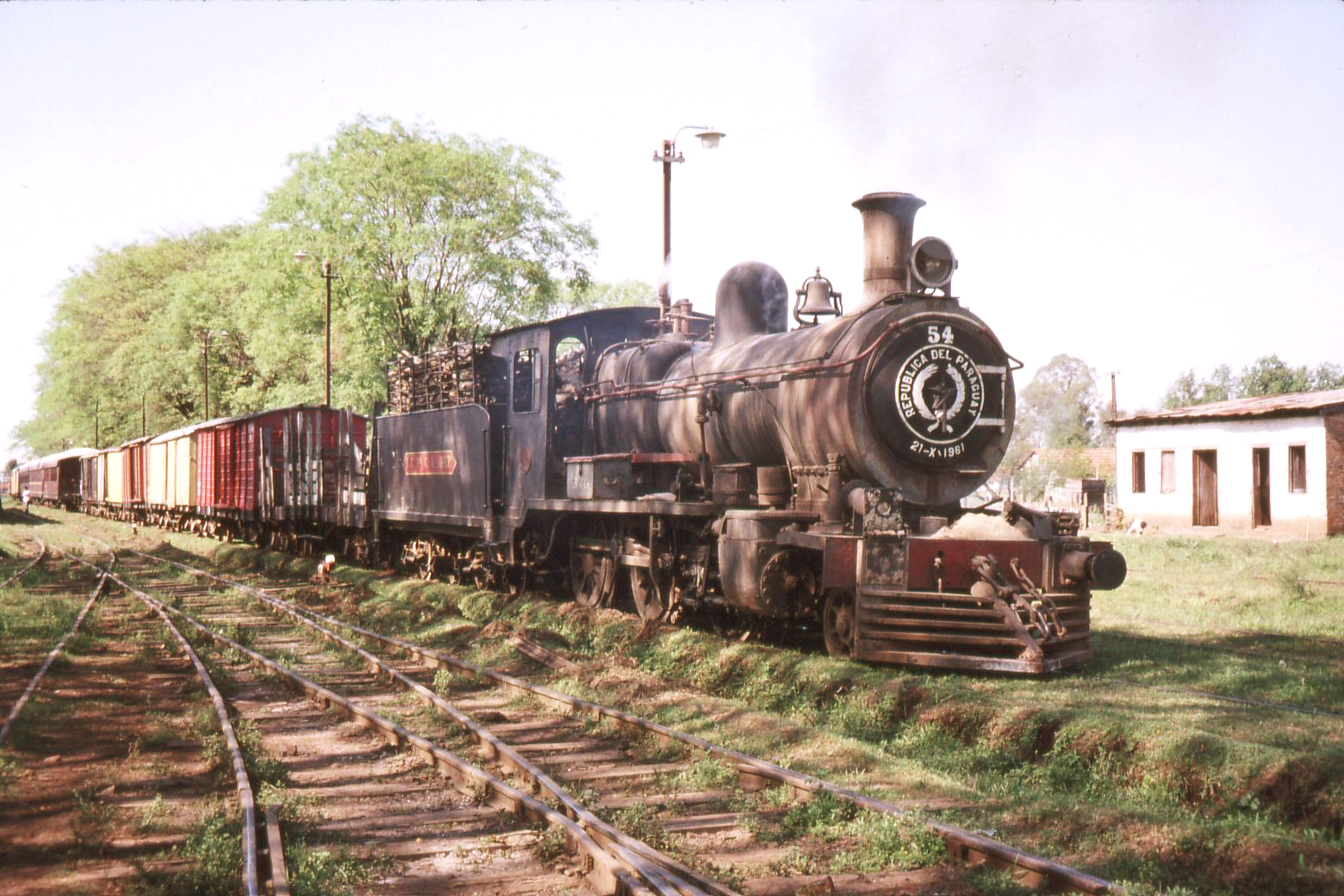
The
track was very overgrown and presented a lush green appearance with
the occasional bright red flowers. There were many stands of bamboo
which, presumably, harbored a lot of snakes. The water came close to
the rails and provided habitats for egrets, ibis, hawks and
gallinules. At one run past the first guy out disturbed many snakes
in the long wet grass. Fortunately, they are not too active at this
time of year.
 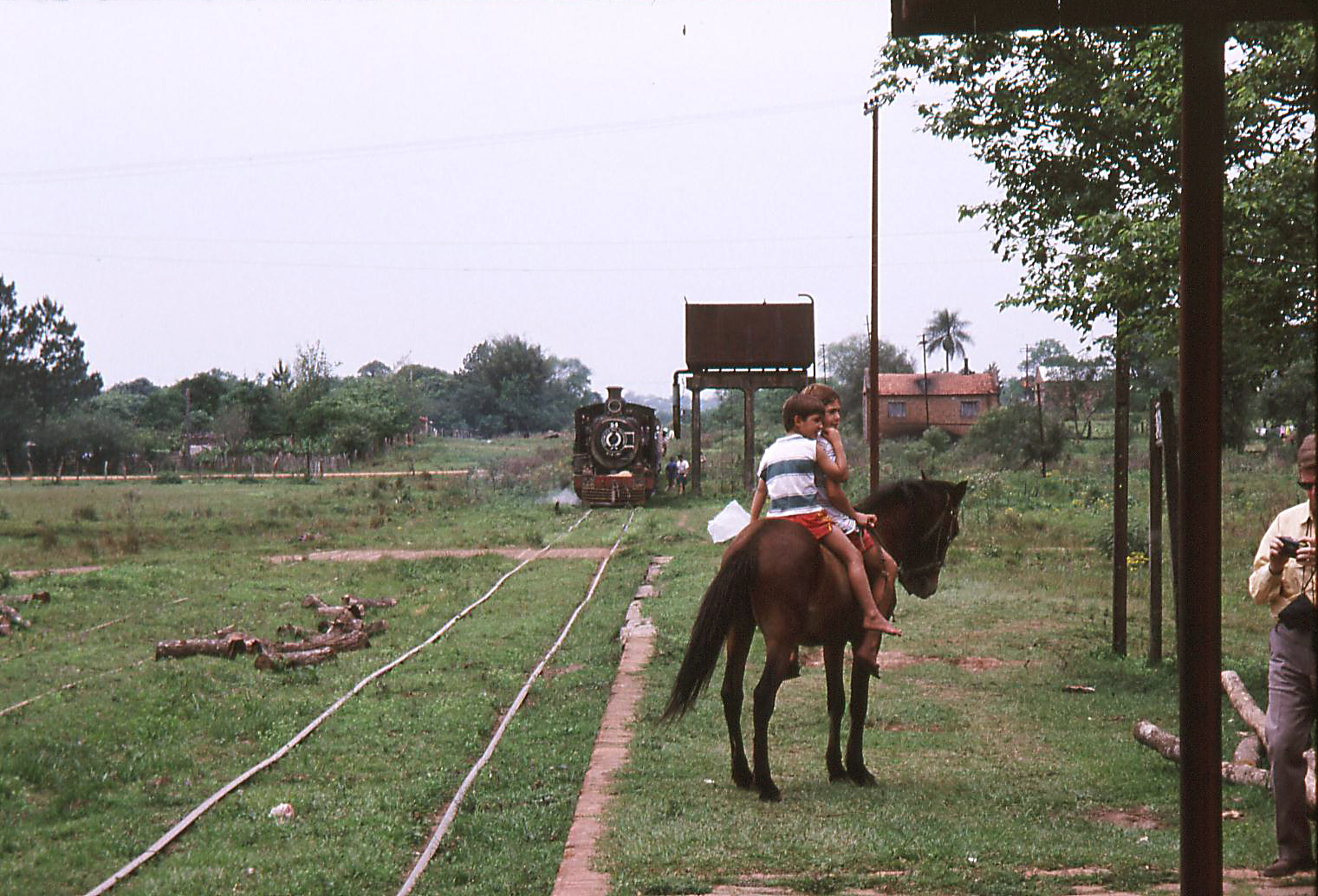
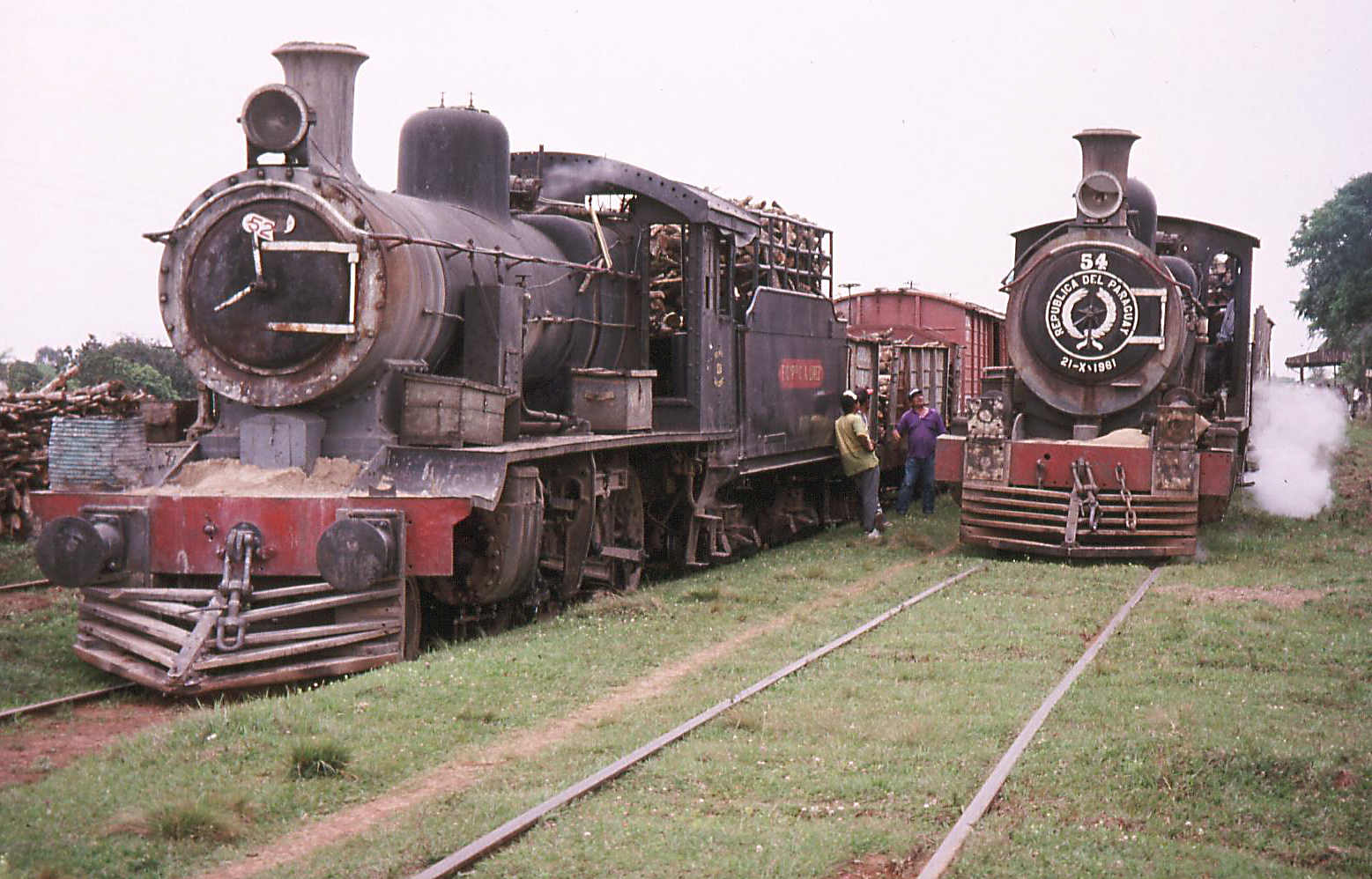 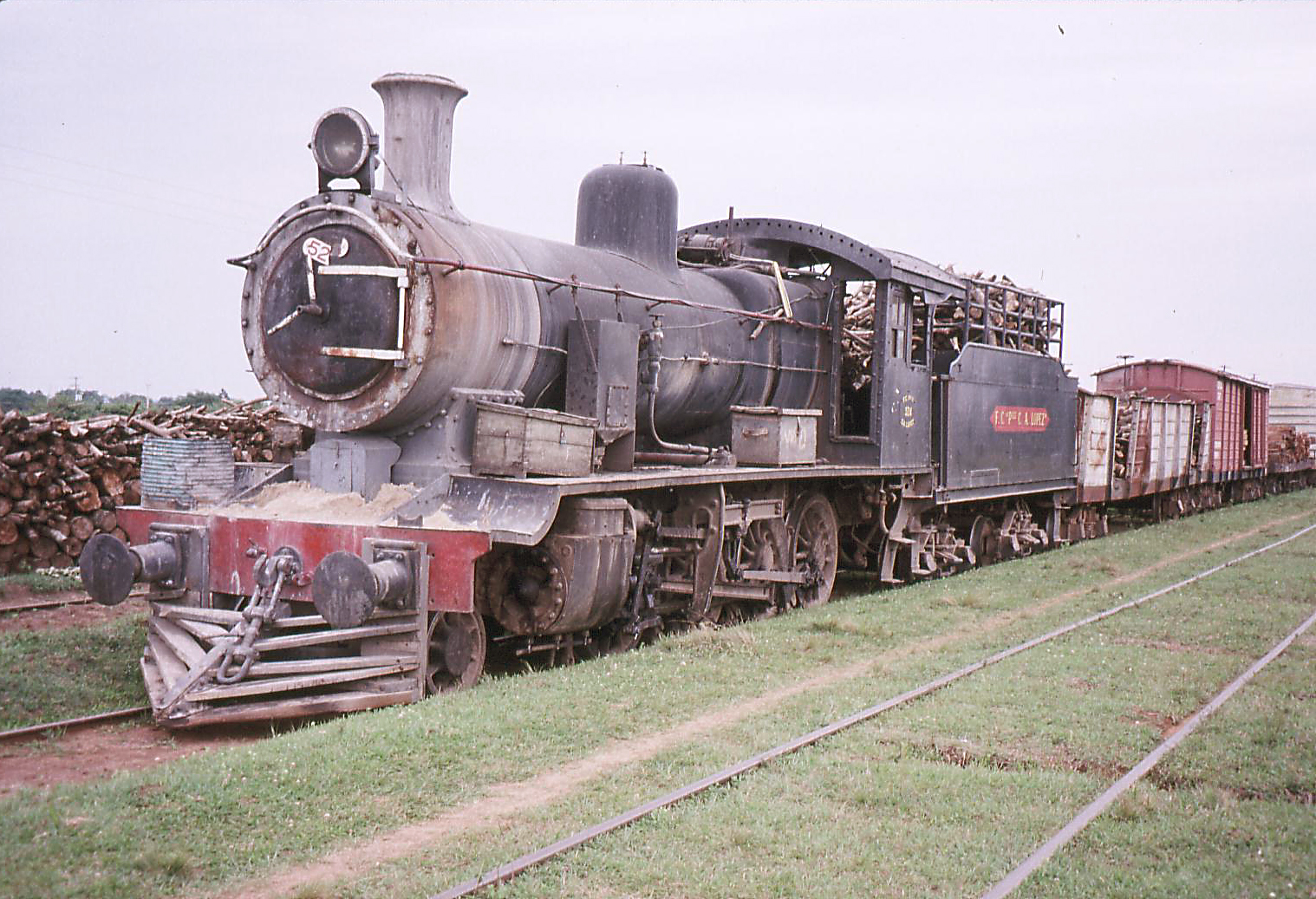
Abogado
We
took water at Carmen where we were watched by two kids on a horse. We
came across a work train at Abogado with #52, 2-8-0 in charge. After a
box lunch we ran straight back to Encarnacion with just one run past
it it was dreary and rained quite heavily. We were not going fast
enough to keep ahead of the mosquitoes. At one point we passed
several banana trees that were growing close to the rails. These had
been planted a few years ago for a Camel cigarette commercial because
the director did not think the area looked enough like the jungle !
As we ran into town it was early evening and there were a lot of
soccer games in progress. Our last sight of the station was with a
group of horses running freely through the yard.
Mary,
in the meantime, having seen the primitive conditions of the freight
consist (nowhere to sit, no bathroom and everything filthy), had
chosen to skip this particular adventure and instead to explore the
town of Encarnacion. She came on the bus to the station with the
group and then walked the few blocks into the waterfront and downtown
area. The mission was to wander around to get a taste for the town,
and also to find a bottle of that Brazilian hot sauce, some
postcards, and some stamps.
The
waterfront area was chockablock with shops and stalls, all selling a
variety of items ranging from the useful (socks, underwear, shoes) to
the tacky (plastic toys and knick knacks) to the smuggled (electronic
equipment, cameras, watches, music tapes ). Paraguay is reputed to be
a smuggler's paradise, with locals bringing in goods from surrounding
countries and selling them cheaply. Although the shops assistants all
stood about outside their doors and hawked their wares, they did so
in a non-intrusive, inoffensive way for the most part.
Mary
found the Brazilian hot sauce very quickly, but postcards were
nowhere to be found. Obviously, Encarnacion is not a tourist site.
The whole area in the waterfront will eventually be underwater.
Walking into the downtown area meant walking uphill, and the
atmosphere changed gradually to office buildings and businesses and
houses. There were some very nice houses in walled gardens. At one
point two well-dressed men strolled ahead of Mary amiably chatting,
then crossed the street to enter bank, and then she noticed that one
of them was carrying a briefcase, and the other one was carrying a
gun and was obviously his bodyguard.
Lunch
could have been in a choice of nice looking restaurants with linear
tablecloths, but Mary chose a greasy spoon instead as being more
appropriate for her hiking booted and backpacked attire. Bad choice,
the food was lousy. But she lucked out in finding a bookstore that
had a rack of postcards in the doorway and made her selection. Then
the quest was on for stamps. The guidebook indicated the post office
was in the waterfront area so off she went, and found the post
office. However, the clerk told her that they had run out of stamps,
and that she should return the next day for them. At that point it
was time to head back to the hotel. There were two options colon take
a taxi for the four mile ride to the hotel, or catch a local bus. She
had seen the bus number at the bus stop down the street from the
hotel, and in her walking around had seen where all the buses seemed
to leave the waterfront area, so decided to try to catch a bus. After
a few minutes wait the right number appeared but the driver said he
didn't go to the hotel. He told her what the sign on the bus should
say, and the next one that came along was the right one so she got on
and headed back. It was a pleasant ride through town and down the
highway, and she was back at the hotel quite fast. The timing was
good because it then began to rain.
When
Colin got back to the hotel, he was filthy and his boots stank. The
first thing he did was to clean the mud and stink off his boots,
then he showered and changed, and washed his dirty clothes. In the
meantime, Mary had written all the postcards. We decided to send
Christina and Veronica a postcard each from each country, and also to
Mr and Mrs Bullock in apartment 704, we had seen an article in the
Citizen about Mary Bullock's postcard collecting hobby. We hoped to
create a pleasant mystery for them about who could it possibly be
that was sending them all these postcards. About a week after our
return we saw Mrs Bullock in the lobby, and she asked us if the
postcards were coming from us. At first we pretended not to know
anything about it, but then we admitted that it was. She seemed
pleased, and said it had puzzled them for a few days before she
thought to call Fay's sister-in-law to ask if we were on vacation in
South America.
We
all went to a pari;;ada in town for dinner. The barbecued meats and
sausage were good although a little overcooked for our taste and
therefore a bit dry. All told, with beer or wine, the cost including
transport, came to $11.00 which was very reasonable.
Friday
20 October 1995
Today
we took a bus back to Asuncion. There was a leisurely departure from
the hotel which gave us the opportunity to look at a couple of small
owls which were nesting in an adjacent field. We made a detour to see
the so-called Jesuit ruins. These are not so much a ruin as an
uncompleted site because the Jesuits were thrown out of Paraguay in
the 1700s before this was completed. It is a large complex on a hill
with a good view in all directions. It proved to be much more
interesting than we expected, and we took a number of shots of the
pillars and walls and statues.
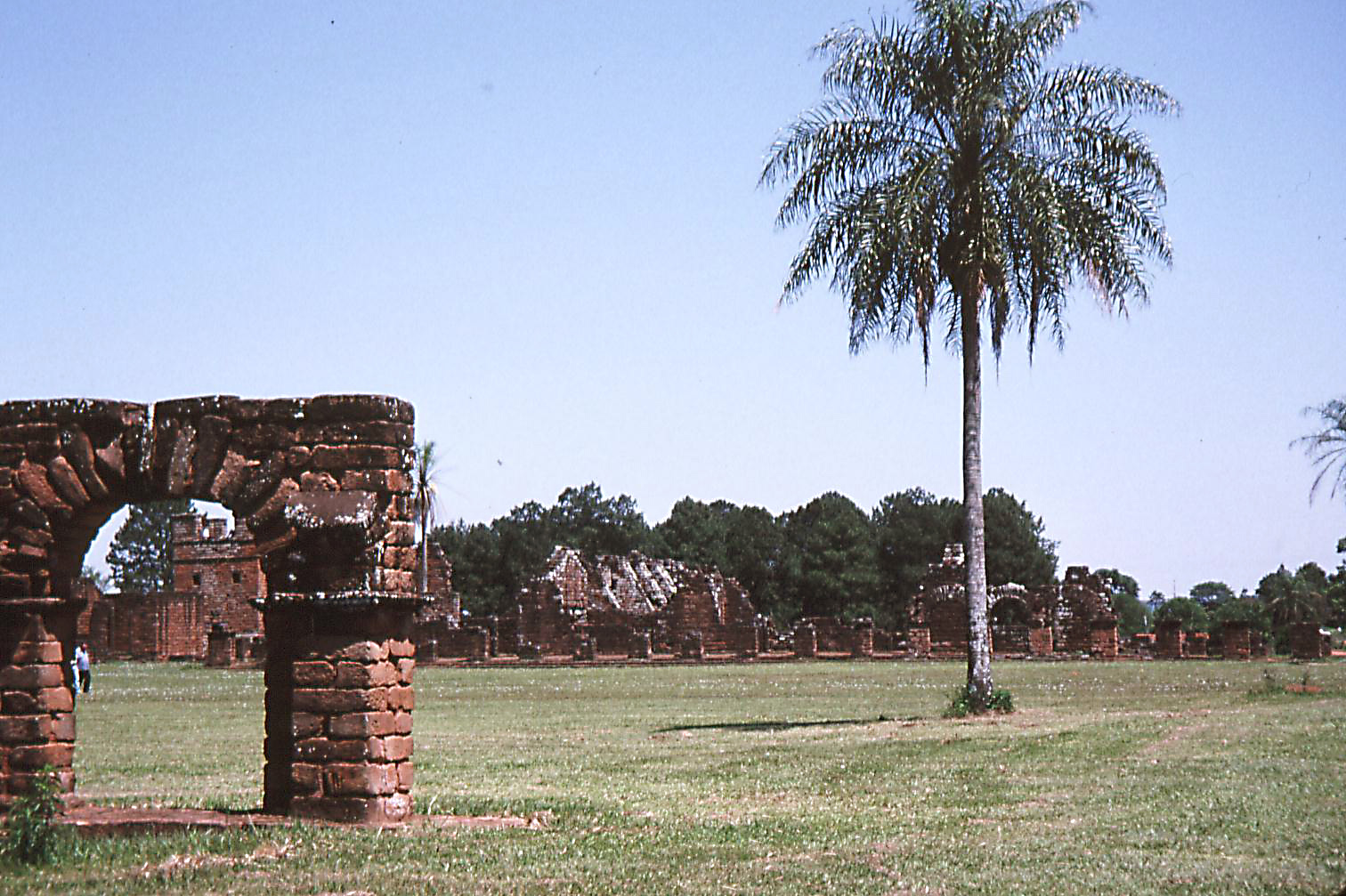 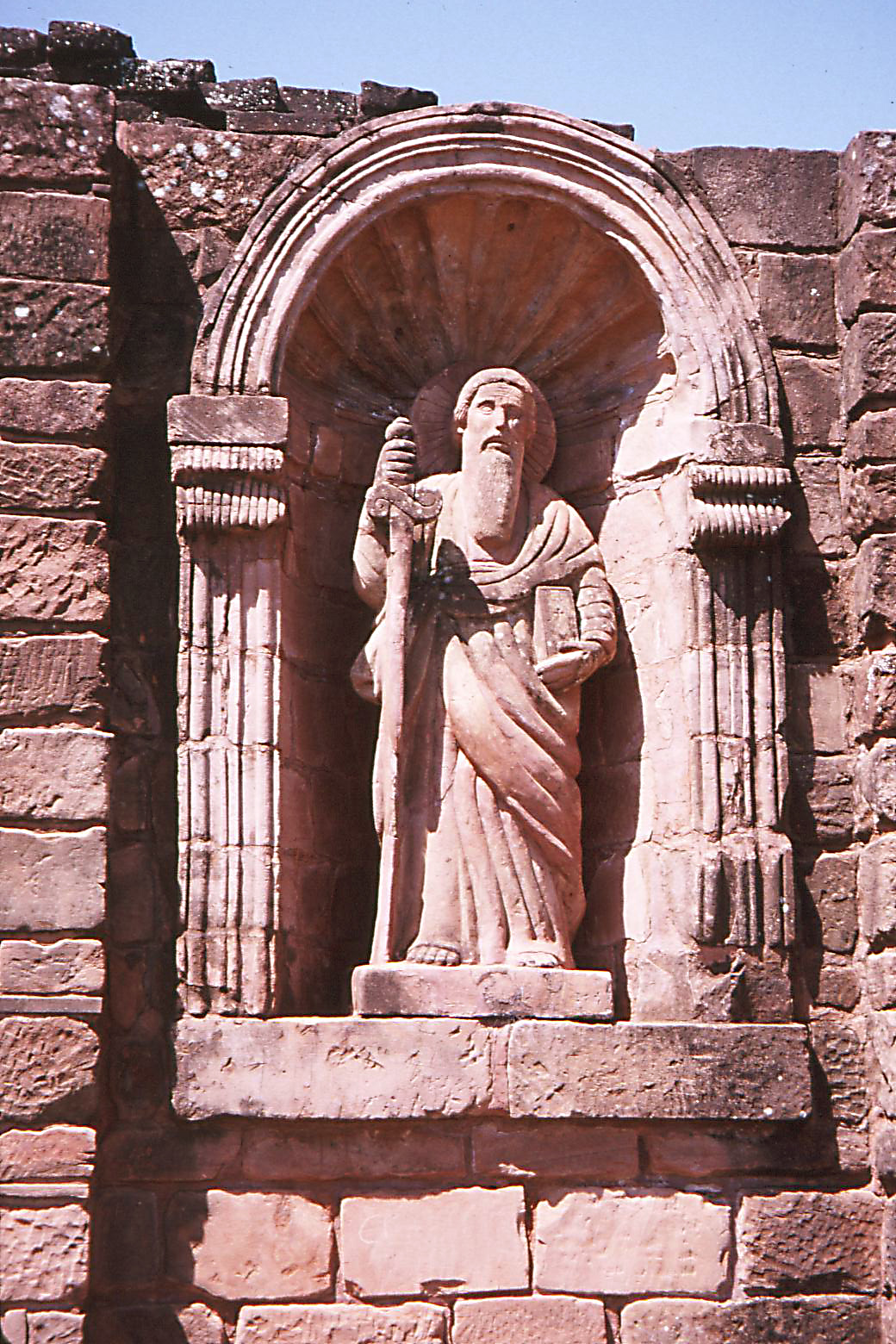
There
are more villages along the highway than along the railway line and
they are more developed. We stopped at the parillada in San Ignacio
where most of us had dorado, a very large lump of fish. A black cat
appeared and was happily fed small pieces of fish under the table. It
seems that we threw the restaurant off balance when we descended upon
them even though the driver had telephoned in advance. The driver had
a chat with us in Castellano and told us that he had to work every
day, seven days a week, that he was poorly paid and that he traveled
great distances to all the countries surrounding Paraguay. He lives
just outside Ascuncion. We didn't have too much difficulty in
understanding each other; we're really pleased that we are able to
get by in Castellano, although we realize that we are massacring the
language.
The
hotel in Asuncion was not good. It was not the same one that we had
stayed in a few days earlier.
Saturday
21 October 1995
Sandy
and Frank's bed collapsed when they got into it last night and they
had to be given another room. We walked up to see the Pettit Rossi
Street market. This is a large area, partly along Pettit Rossi and
partly away from the street. Just about everything imaginable was on
sale. Colin likee the look of the leather goods, including several
saddles and a bandoleer for carrying bullets.
We
walked back to the station and found out that a school special was
about to leave, probably the only train of the day. It was hauled by
#226 while #152 and #286 were in the yard. The train of former
Argentinian coaches had been decorated with bunting and there was a
great noise from the kids and their parents. Many of them sitting
three to a seat. When one of the train crew blew his whistle there
was a great cheer from the train and it staggered its weary,
boisterous way out of the station.

Leaving Asuncion
 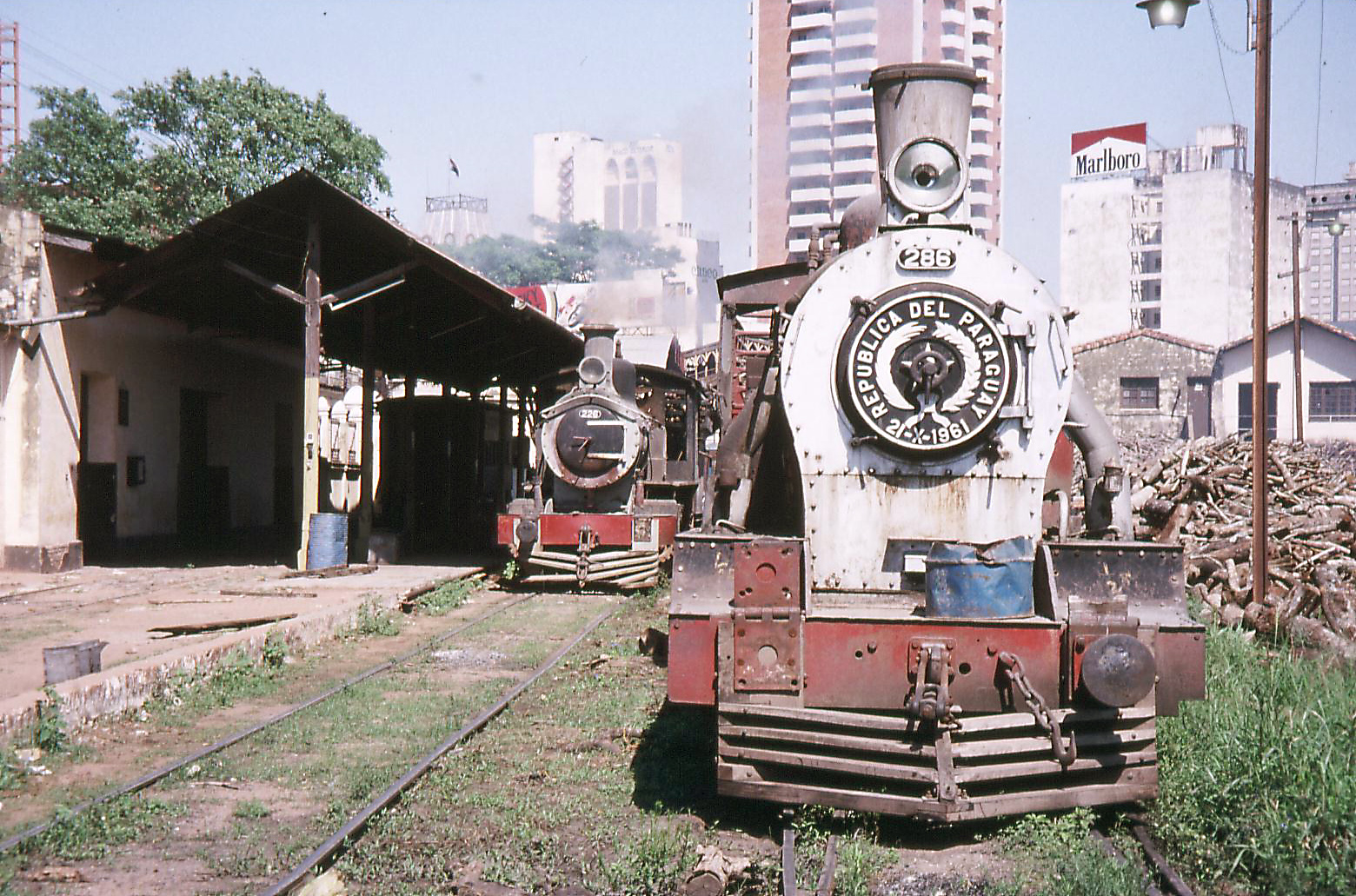
Asuncion Yard
We
then took a walk past the post office towards the presidential
palace. At one time in the last century there was a law that anyone
who gazed at the palace would be put to death. There is a street
market on Saturdays along one of the roads used by the streetcars so
there is no Saturday service. The Central Square was full of people
selling locally made handicrafts but we only saw one beggar.
Lunch
was pizza at Tiohuaca's along with beer served from an ice bucket.
The pizza seemed ridiculously cheap until we received the bill to
find out that the price was per slice and not per pizza. It was still
very good. We finished it off with cappuccino and dulce de memorillo
and queso (jam and cheese). We took a bus to the airport along
streets lined with orange trees. Mary spent our last guarani at the
airport on her first and last drink of guarana (a local sweet, fizzy
drink), and two packets of chocolate cookies.
The
flight to Santiago was uneventful except that the luggage rack
opposite opened both on takeoff and landing and a lady was hit on the
back of the head by an EXIT sign when we were exiting. Ladako have a
pre-arranged service through which we were met at the arrivals and
takeen by minibus to the Crowne Plaza Holiday Inn. We found a beer
hall type restaurant and had beer with escalope Cordon Bleu and
pork. Both pieces of meat were enormous and there was way too much
food so late at night.
Click here to see the continuation in Chile
|
